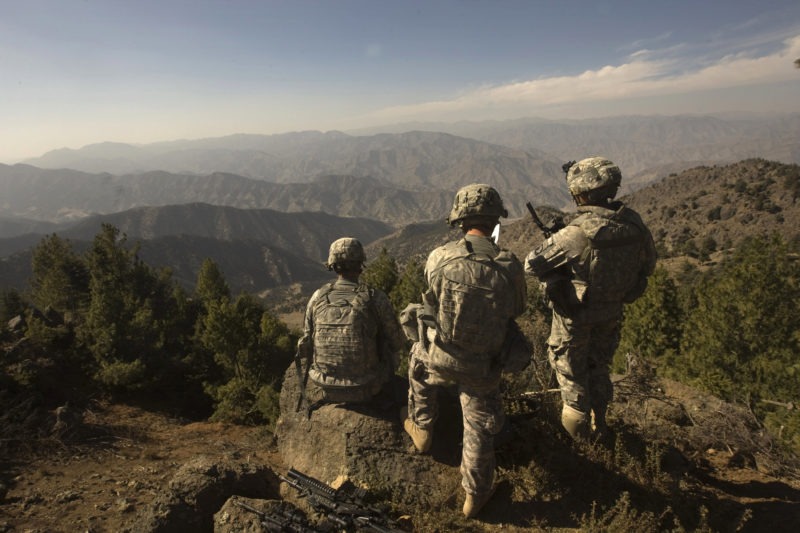Afghanistan: A look at war-torn nation’s troubled past
At the peak of international action in Afghanistan, about 130,000 soldiers from some 50 nations helped the government assert control (DAVID FURST)
Paris (AFP) – Afghanistan’s recent past has been marked by successive waves of war and unrest, and despite years of foreign investment the nation remains one of the world’s poorest.
Here is a look at the landlocked Islamic republic wedged between Pakistan, Iran and Central Asia.
– Road to Russian occupation –
Afghanistan was ruled by the Durrani line of the dominant ethnic Pashtun group from 1747 to 1973. The last king, Mohammed Zahir Shah, abdicated following a coup by his cousin that established a republic.
Communists seized power in 1978, followed in December 1979 by a Soviet invasion to prop up the government.
But the Red Army met massive resistance from Afghan mujahideen rebels, financed and armed by the United States, and withdrew in defeat 10 years later.
A bloody civil war erupted between mujahideen factions in 1992 after the collapse of Mohammad Najibullah’s communist government.
– Civil war and the Taliban –
The communist collapse lead to fighting that is believed to have killed and wounded tens of thousands of people in two years and partly destroyed the capital, Kabul.
In 1994 the Pakistan-backed fundamentalist Taliban movement began to emerge in the south and quickly claimed large parts of the country, culminating in September 1996 with their seizure of Kabul and creation of a government based on a hardline interpretation of Islamic Sharia law.
Led by Mullah Mohammad Omar, the Taliban banned women from working, closed girls’ schools, and forbade music and other entertainment.
Under severe UN sanctions, the regime grew close to the Al-Qaeda jihadist network and sheltered its leader, Saudi national Osama bin Laden.
– US-led invasion –
In October 2001 the US led an invasion of Afghanistan in retaliation for Al-Qaeda’s September 11 attacks on Washington and New York.
Washington and its NATO allies quickly ousted the Taliban and brought Hamid Karzai to power, funnelling in billions of dollars of aid to rebuild the war-ravaged country.
At the peak of international action, about 130,000 soldiers from some 50 nations helped the government assert control while the Taliban were forced into hiding or fled to neighbouring countries, especially Pakistan.
But the Islamists regrouped as an insurgency, and the US shifted its focus to the war raging in Iraq.
– Insurgency –
NATO pulled its combat troops at the end of 2014, with the Taliban insurgency raging, though thousands remained to carry out anti-terrorist operations and train Afghan forces.
The Taliban continued making gains and carrying out major attacks. By 2015, the Islamic State had begun making inroads in Afghanistan, particularly in Nangarhar province, on the border with Pakistan.
Faced with crumbling security, the US in July 2016 reversed plans to slash the US troop presence, instead sending more in 2017.
In December 2018, with about 14,000 US soldiers in Afghanistan, President Donald Trump said he wanted to halve the American military presence.
That same year, Afghanistan had overtaken Syria as the deadliest country worldwide and a UN tally put the civilian death toll for the year at 3,804 — including more than 900 children.
– Fallout –
War sent has hundreds of thousands of Afghans fleeing, mostly to neighbouring Iran and Pakistan, and many have remained after the Taliban fall.
In 2018 Afghanistan was the world’s second-largest refugee-producing country behind Syria, at 2.6 million people, according to the UN refugee agency.
Around 55 percent of the remaining population of about 35 million lived on less than $1 a day in 2017, according to Afghanistan’s statistics office.
Despite some progress since the Taliban’s ouster, Afghanistan’s literacy rate is one of the world’s lowest, at under a third of the adult population and just an estimated 17 percent of women.
In June 2018 the UN said nearly half of Afghanistan’s children were not attending school because of worsening security, poverty and sex discrimination.
– Top opium producer –
Afghanistan is the world’s biggest opium producer, accounting for 90 percent of the raw material for heroin despite costly international eradication efforts, and profits are a major source of Taliban funding.
Conflict and endemic corruption have shredded Afghanistan’s infrastructure and economy, with most people relying on agriculture in the largely rural and drought-plagued country, which also has reserves of iron, copper, cobalt and lithium.
Disclaimer: Validity of the above story is for 7 Days from original date of publishing. Source: AFP.


